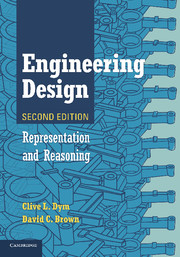Book contents
- Frontmatter
- Contents
- Preface
- Preface to the First Edition
- Acknowledgments
- 1 Framing the Issues
- 2 Engineering Design
- 3 Characterizing the Design Process
- 4 Taxonomies of Engineering Design
- 5 Representing Designed Artifacts
- 6 Representing Design Processes
- 7 Where Do We Go from Here?
- References Listed in First Edition
- New References
- Index
5 - Representing Designed Artifacts
Published online by Cambridge University Press: 05 June 2012
- Frontmatter
- Contents
- Preface
- Preface to the First Edition
- Acknowledgments
- 1 Framing the Issues
- 2 Engineering Design
- 3 Characterizing the Design Process
- 4 Taxonomies of Engineering Design
- 5 Representing Designed Artifacts
- 6 Representing Design Processes
- 7 Where Do We Go from Here?
- References Listed in First Edition
- New References
- Index
Summary
We now turn to the representation of designed artifacts. By focusing first on objects, we risk introducing an artificial distinction into the scope and meaning of design knowledge. Clearly, design knowledge must incorporate information about design procedures, shortcuts, and so on, as well as about artifacts. Furthermore, there is some evidence that designers think about processes as they begin to represent the objects they are designing, especially when they begin to create sketches and drawings. And, of course, to fully represent objects and their attributes also means being able to fully represent concepts (e.g., design intentions, plans, behavior, and so on) that are perhaps not as easy to describe or represent as physical objects. However, because the end point of most engineering designs is a set of fabrication specifications for an object (and, occasionally, the object itself) and because engineers often think in terms of devices, we start our discussion of representation with physical objects as our focus. As a consequence, we may somewhat overlap our later discussion (cf. Chapter 6) of the representation of design knowledge and design processes.
The Languages of Engineering Design
To discuss different representations of designed objects or artifacts is to talk about the languages or symbols in which those representations are cast. That is, for us to describe an object, whether real or conceptual, in detail or abstractly, we must effectively choose a language with which to write our description.♦
- Type
- Chapter
- Information
- Engineering DesignRepresentation and Reasoning, pp. 69 - 112Publisher: Cambridge University PressPrint publication year: 2012

